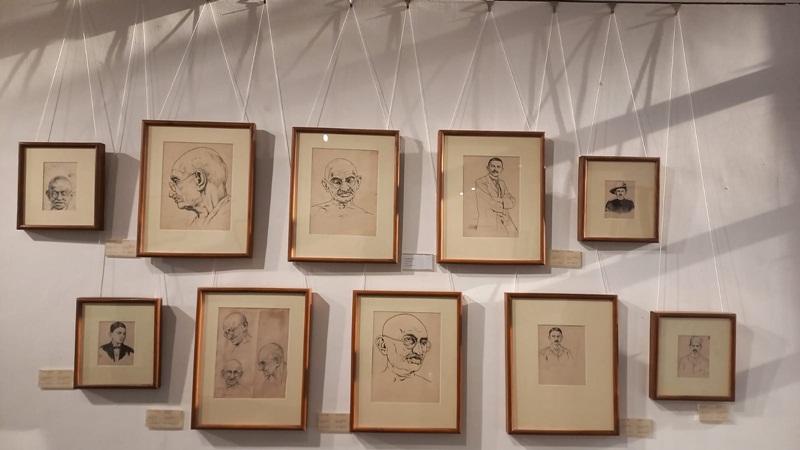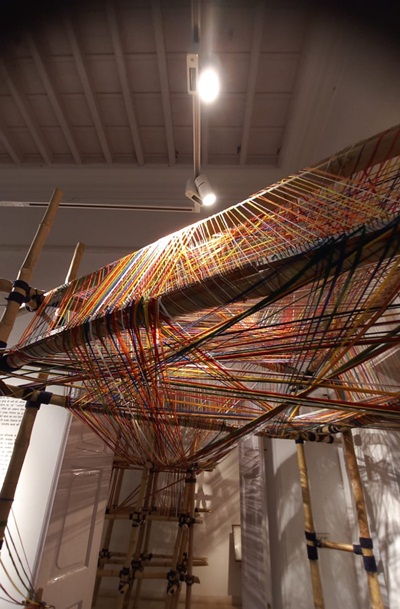In Maharathi’s sketches and paintings, Gandhi’s persona assumes a larger than life image, capturing him in different segments of public and personal moments.

The National Gallery of Modern Art has been observing the 75th year of Indian Independence through a series of exhibitions and art installations. As part of this series, the Gallery put up a superbly curated exhibition on Upendra Maharathi, entitled ‘The Eternal Seeker’. Maharathi, a modernist from Bihar, was trained at the Government Art College, Calcutta and was heavily influenced by the Bengal Movement of Art, centred around Santiniketan. Between the late 19th and early 20th century, the Bengal Art Movement shaped the aesthetic sensibility of many a contemporary artist. Spearheaded by the Tagore scion Abanindranath, and the legendary Nandalal Bose, this school moulded Maharathi’s attitude towards art and design. The ‘swadeshi’ and the ‘videshi’ blended in his unique expressions. In his multi-faceted career, Upendra Maharathi was a polymath. He worked as an artist, craftsman, architect, designer, Gandhian activist and a later day ambassador of the Indian Council for Cultural Relations.
As early as in the 1940s, Maharathi worked towards textile and crafts revival within rural communities of Bihar. Government of India’s much touted Cottage Industry business was founded upon the passionate labour of people like Maharathi and their commitment towards reviving indigenous arts and crafts. Of course, the doyen in this field is Kamaladebi Chottopadhyay. The ‘bavanbuti ‘ thread weaving (fabric with 52 rounds) emerges from the weavers of the Nalanda heirlooms. These weavers were singularly responsible for massive revenue generation for the coffers of the colonial administration. Heavy taxation, famines and poor infrastructure took this legacy to a point of extinction. Maharathi’s love and labour revived the fortunes of the weaver community. He set up training schools, provided necessary infrastructure and formulated an intellectual framework for the style of weaving by writing books on them. Word must be reserved for the innovative curation- fabrics and looms juxtapose paintings and crafts from Maharathi’s personal collections. Both of these categories showcase the very best of Mithila and Nalanda Schools of art. The Gallery’s spaces have been re-configured to Maharithi’s laborartory, displaying his sketches, blueprints, designs, books, desks and the lot. What comes out in this curation, is Maharathi’s attempt to make his art a part of his community. Whether these are his own creations or his collectibles, every piece of art speaks about a ‘gharana’, a sense of belonging to an indigenous solidarity.
The tumultuous years of the 1940s had a deep impression on Maharathi’s canvas. Not only did he shift his focus to exploring the ‘native’, but the political and the personal also merged in his philosophy. His response to the dehumanizing scenes of Bengal Famine and the Partition is captured through his abstract portrayals, swirls of colours depicting the horrors of the events. These paintings raise questions about colonial and post-colonial India’s ‘national’ identity.
The exhibition had a stunning range of his creations—Orientalist paintings inspired by his visits to Japan, as also furnitures and architectures of the Mauryan style. But it was the Gandhi segment that stole the show. A factor that galvanized Maharathi’s work and vision is his interaction with Gandhi. He affixes on Gandhi a spiritualist mission, positioning his persona, next only to the Buddha and the Christ. In Maharathi’s sketches and paintings, Gandhi’s persona assumes a larger than life image, capturing him in different segments of public and personal moments. He observed Gandhi during the Ramgarh Congress of 1940, and found in him a Muse for his canvas. There is no doubt that in Maharathi’s early nationalist imaginings, we find a tradition of the Gandhi brand-making, to emerge in later years.
∎
